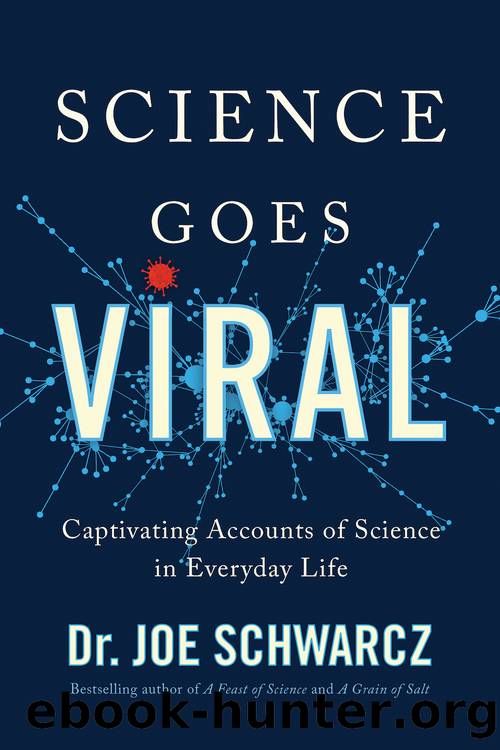Science Goes Viral by Schwarcz Joe;

Author:Schwarcz, Joe;
Language: eng
Format: epub
Publisher: ECW Press
Published: 2021-10-26T00:00:00+00:00
Graduating to Bioplastics
In the classic film The Graduate, a family friend corrals young Benjamin, who had just graduated from college, and whispers into his ear: âPlastics.â The year was 1967 and plastics were the âmiracle materialsâ that changed lives. Virtually every industry from airplane and car manufacturers to hospital equipment and cookware suppliers benefited from plastics. Women flocked to Tupperware parties and vinyl records were the rage. My, how times have changed! Plastics have become a pariah, pollutants that are sullying and endangering the environment. If Benjamin were embarking on a career today, the whispered word would likely be âbioplastics,â with further qualifiers such as âdegradable,â âbiodegradable,â âoxo-degradable,â ârecyclable,â or âcompostable.â
These terms have infiltrated advertising as the plastics industry attempts to cope with the negative image of beaches defiled with plastic bottles, garbage patches in the ocean, shopping bags in gutters, and straws up turtlesâ noses. Indeed, items made from the most common plastics, such as polyethylene (PE), polypropylene (PP), polyethylene terephthalate (PETE), and polyvinyl chloride (PVC), are extremely durable and can stay around in the environment for decades and decades.
That polyethylene hula hoop purchased back in the 1950s looks none the worse for wear, and that plastic bottle carelessly tossed into the ocean from a boat may float for decades before being battered enough by waves to break into smaller pieces that can then be mistaken for food by fish and end up in their stomach, and eventually, in ours.
Most plastics are made from natural gas or petroleum, which is another concern since these are nonrenewable resources. So, we have a dual challenge. Find ways to cut down on the amount of plastic that gets discarded and find renewable resources that can be converted into bioplastics.
Bioplastics are produced partly or wholly from living species such as plants or microbes rather than from fossil fuels. An example would be polylactic acid (PLA), made from lactic acid, which in turn is produced by the action of lactic acid bacteria on starch from corn, cassava, sugarcane, or sugar beets. PLA is deemed to be a âgreenâ plastic because it is made from a renewable resource. It can be used to make transparent drinking cups, disposable tableware, and teabags.
However, bioplastics are not necessarily biodegradable. That term refers to substances that can be broken down by microbes normally found in the environment. Food scraps, human and animal waste, paper, wool, and fallen leaves are biodegradable, but the speed at which this happens depends on the conditions. A cup made of PLA will biodegrade quite quickly if buried in soil but will not break down in a landfill. It is, however compostable, which is why it is used to make compost bags. Note, though, that compostable does not mean that the plastic will break down in the compost heap in your backyard. âCompostableâ on a label means that in a proper composting facility where temperature and pressure are strictly controlled, it will decompose into carbon dioxide, water, and a complex mixture of organic compounds such as cellulose, hemicellulose, and lignin, referred to as biomass.
Download
This site does not store any files on its server. We only index and link to content provided by other sites. Please contact the content providers to delete copyright contents if any and email us, we'll remove relevant links or contents immediately.
Sapiens: A Brief History of Humankind by Yuval Noah Harari(13052)
The Tidewater Tales by John Barth(12030)
Do No Harm Stories of Life, Death and Brain Surgery by Henry Marsh(6336)
Mastermind: How to Think Like Sherlock Holmes by Maria Konnikova(6235)
The Thirst by Nesbo Jo(5785)
Why We Sleep: Unlocking the Power of Sleep and Dreams by Matthew Walker(5641)
Sapiens by Yuval Noah Harari(4537)
Life 3.0: Being Human in the Age of Artificial Intelligence by Tegmark Max(4507)
The Longevity Diet by Valter Longo(4445)
The Rules Do Not Apply by Ariel Levy(3905)
The Immortal Life of Henrietta Lacks by Rebecca Skloot(3826)
The Body: A Guide for Occupants by Bill Bryson(3800)
Why We Sleep by Matthew Walker(3771)
Animal Frequency by Melissa Alvarez(3755)
Yoga Anatomy by Kaminoff Leslie(3701)
Barron's AP Biology by Goldberg M.S. Deborah T(3631)
The Hacking of the American Mind by Robert H. Lustig(3580)
All Creatures Great and Small by James Herriot(3515)
Yoga Anatomy by Leslie Kaminoff & Amy Matthews(3395)
